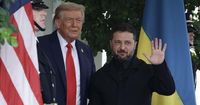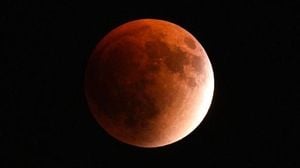On a sweltering Monday in mid-August 2025, President Donald Trump welcomed Ukrainian President Volodymyr Zelensky to the White House, flanked by a cadre of reporters. With characteristic bravado, Trump declared, “I’ve ended six wars.” By the next day, the number had grown: “I’ve solved seven wars,” he told Fox & Friends. The White House, when pressed, offered no clear answer as to which wars Trump was referencing. Yet, as the world watches, the President’s claims—and the reality behind them—are shaping a new chapter in American foreign policy, one defined by headline-grabbing deals, bold summits, and a relentless pursuit of the Nobel Peace Prize.
Trump’s penchant for dramatic announcements is nothing new. But in the summer of 2025, the stakes are higher than ever. The world is still reeling from Operation Midnight Hammer, the U.S.-led strikes on Iran’s nuclear facilities just two months prior, which were quickly followed by a ceasefire between Israel and Iran. According to the Los Angeles Times, this ceasefire, though initially fragile, has managed to hold—at least for now. Yet, as with many of Trump’s claimed triumphs, the underlying issues remain unsettled, and the future of Iran’s nuclear ambitions is far from clear.
In the weeks since, Trump has shifted his focus to the grinding war in Ukraine, a conflict that has devastated the region since Russia’s invasion in February 2022. The humanitarian toll has been staggering, and attempts to broker peace under previous administrations have repeatedly faltered. As the Los Angeles Times notes, the Biden administration’s approach—marked by strong rhetoric, hefty aid packages, and unwavering support for Ukraine—failed to produce a roadmap to peace. Trump, for his part, has seized the opportunity to contrast his “America First” realism with what he calls the “liberal internationalist fantasy” of his predecessor.
Trump’s recent diplomatic blitz has included high-profile summits: one with Russian President Vladimir Putin in Alaska, and another in Washington with Zelensky and European leaders. These meetings, as reported by the Los Angeles Times, have produced what some observers describe as the clearest strategy yet for ending the Russia-Ukraine war. Trump’s plan, in broad strokes, hinges on four principles: Ukrainian neutrality (no NATO membership), land swaps and territorial compromise, a European-backed reconstruction package, and robust enforcement mechanisms. “Neutrality means Ukraine doesn’t join NATO—period,” the Los Angeles Times summarizes, echoing Trump’s insistence that the alliance’s eastward expansion helped spark the conflict in the first place.
Of course, such a deal is easier said than done. The prospect of Ukraine ceding territory—Crimea and parts of the Donbas region, for instance—is a bitter pill for many in Kyiv to swallow. Yet, the Trump administration argues that self-determination and lasting peace must take precedence over endless proxy war. According to the Los Angeles Times, Trump is also dangling the promise of a Marshall Plan-style economic revival for Ukraine, conditional on the success of a peace agreement. A recently inked mineral rights deal between the U.S. and Ukraine adds another layer of economic incentive.
Enforcement, always the trickiest part of any peace deal, remains an open question. Trump’s model, as described by the Los Angeles Times, rejects NATO-style mutual defense guarantees in favor of a more transactional, interest-based approach. The details are still emerging, but the administration insists that “getting this part of the deal right will be crucial.”
Trump’s self-proclaimed peacemaking extends well beyond Ukraine. On May 10, he announced on Truth Social that India and Pakistan had agreed to a “FULL AND IMMEDIATE CEASEFIRE” after “a long night of talks mediated by the United States.” Pakistan quickly endorsed Trump’s account, even nominating him for the Nobel Peace Prize for his “decisive diplomatic intervention and pivotal leadership.” India, however, has consistently downplayed U.S. involvement, stating that the ceasefire was the result of direct negotiations with Pakistan. The truth, as is often the case in geopolitics, is murkier than the headlines suggest.
In Central Africa, Trump’s administration helped broker a pause in fighting between Rwanda and the Democratic Republic of the Congo, culminating in a preliminary peace deal at the White House in June and a subsequent ceasefire in Qatar in July. Yet, as Foreign Policy reports, the ceasefire has not held. Peace talks collapsed after the Rwandan-backed M23 rebel group walked away, highlighting the fragility of such agreements.
Southeast Asia has seen similar dynamics. A deadly flare-up between Cambodia and Thailand in July resulted in more than 40 deaths and the displacement of over 300,000 people. The ceasefire, brokered primarily by Malaysia, saw involvement from both the U.S. and China. Trump, never one to miss an opportunity, took credit on social media: “I am pleased to announce that, after the involvement of President Donald J. Trump, both Countries have reached a CEASEFIRE and PEACE.” Yet, as Foreign Policy points out, the situation remains fragile, and Trump’s actual influence is subject to debate.
Trump’s most clear-cut diplomatic branding may be in the Caucasus, where Azerbaijani President Ilham Aliyev and Armenian Prime Minister Nikol Pashinyan signed a deal in Washington this August to settle their dispute over the Zangezur corridor. The corridor, now renamed the “Trump Route for International Peace and Prosperity,” comes with a U.S. company securing leasing rights for its development. The symbolism is hard to miss—and, for Trump, perhaps irresistible.
Other efforts are less clear. Trump has claimed credit for “making peace” between Egypt and Ethiopia, who have long sparred over a hydroelectric dam project. While he did play a role in mediating talks, the dispute is far from settled. Similarly, Trump has touted his involvement in Serbia and Kosovo’s economic normalization—a significant step, but not the resolution of a hot war.
As Trump continues to tout his diplomatic achievements, critics and allies alike are left parsing the difference between substance and showmanship. The facts on the ground are often more complicated than the President’s pronouncements. Ceasefires remain tenuous, peace deals are peppered with caveats, and many of the world’s most intractable conflicts are far from resolved. Still, as the Los Angeles Times observes, Trump’s willingness to break with foreign policy orthodoxy—sometimes to the chagrin of America’s traditional allies—has produced results where others have failed.
Whether Trump’s “art of the deal” will yield enduring peace or merely temporary respite remains to be seen. For now, the President’s bold claims and unconventional diplomacy have redrawn the map of global conflict resolution—and set the stage for a new era in American foreign policy, one in which the pursuit of national interest, not moral posturing, takes center stage.





